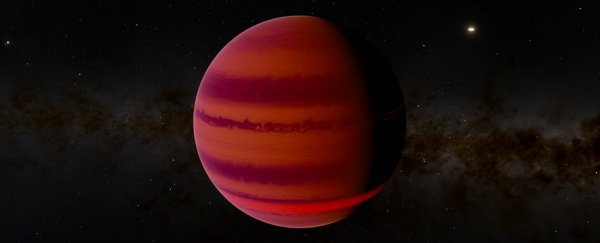The Universe is full of oddball objects that simply don't sit neatly into categories. Take a hint, Pluto.
Astronomers have used the light-warping effects of gravity to spot a massive object that could be a huge planet or a failed star, right in the centre of our galaxy. Not only is it a fun astronomical puzzle, but it's also pushing the limits of the tools we have for watching space.
NASA's Spitzer space telescope has been following Earth's orbit around the Sun since 2003, using its infrared camera to capture stunning images of the heavens.
One task for astronomers has been to use Spitzer's images to find exoplanets; a goal nobody had considered when it launched. The more 'traditional' approach is to watch for the dimming of a star as a planet passes in front of it.
But Spitzer has another trick up its sleeve – microlensing. Gravity is the warping of space, which means a massive object can bend space into what is effectively a lens. Spitzer has been used to find a few exoplanets this way.
But this one takes the cake. If not the whole buffet. (That is, if it's a planet at all.)
Its name is OGLE-2016-BLG-1190Lb, and this beast is a whopping 13 times the mass of Jupiter and orbits a star about 22,000 light years away, in the busy neighbourhood of the Milky Way's centre.
OGLE might not quite as big as the record-breaking behemoth DENIS-P J082303.1-491201 b, which is 29 times the mass of Jupiter. But it's up there.
Before we get too excited, it could still be a brown dwarf star - a boring wannabe that isn't even big enough to spark a serious nuclear furnace. While tiny stars aren't unknown, OGLE's mass puts it at the lower limit of what's needed to get the party started.
So why should we care?
The interesting thing is OGLE sits on the edge of what's known as the brown dwarf desert – a range of orbits described as a zone devoid of failed stars.
Astronomers have noticed there's a distinct lack of brown dwarfs within 5 AU of other stars. For perspective, the distance from Earth to the Sun is 1AU, or about 150 million kilometres.
OGLE has an orbit roughly 5 AU from its companion star that takes about three years to complete. If it is a planet, it's grown to mammoth proportions.
If it's a small brown dwarf, the fact it sits on the border could help us understand more about the ways cosmic objects grow into stars.
More information is clearly needed, and microlensing as a technique is still in its infancy. But it could be powerful, identifying details about stars, planets, and even galaxies other methods can't.
By perfecting processes that can pull more details from the warped light, especially viewed using different satellites from different positions, we should be able to gain a better understanding of the relationship between stars and their orbiting family members.
So here's to you, OGLE. Whatever the hell you are.
This research has been submitted to the Astronomical Journal. It can be found on the pre-publish website arXiv.org.
